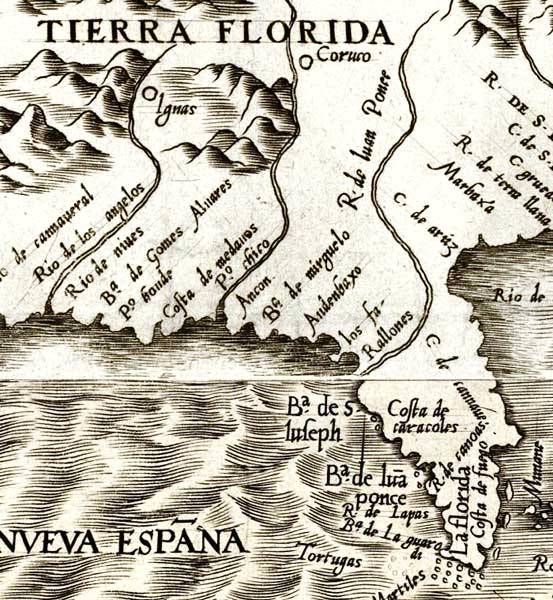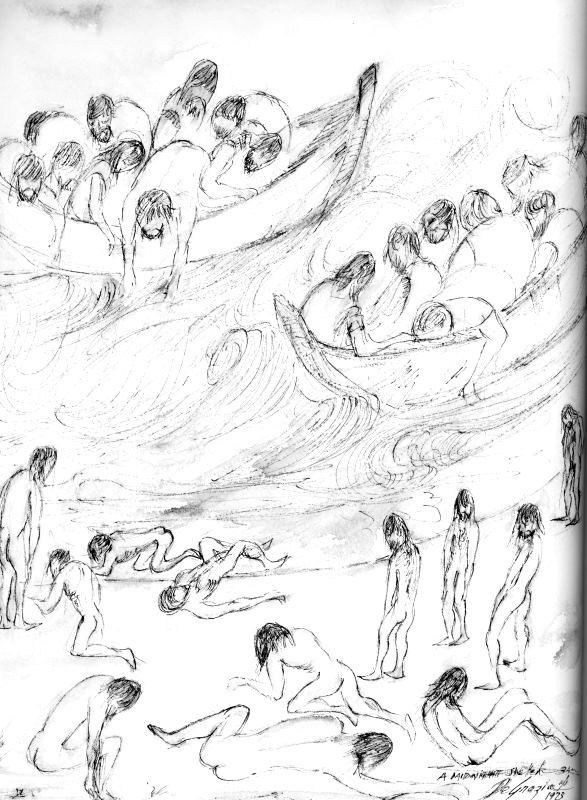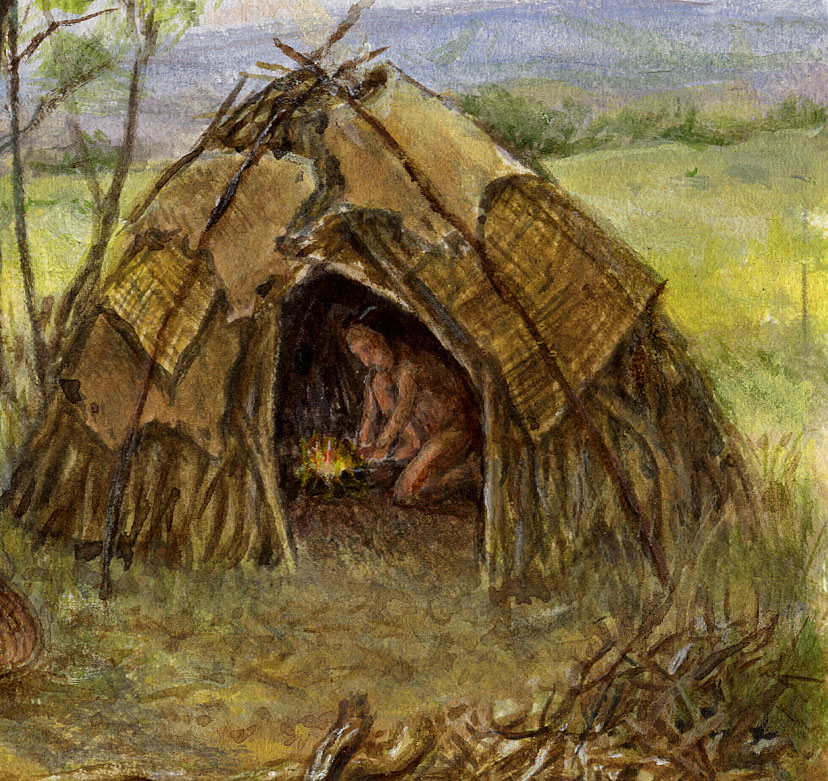|
Prior to being shipwrecked on Galveston Island, the Spanish expedition of more than 400 men and a few dozen horses spent several months traveling along the Gulf coast of the land known to them as La Florida. From the outset, their contacts with Florida´s native people, including agriculturally based chiefdoms, were violent and ultimately resulted in dozens of deaths on both sides. As with other conquistadores, the expedition´s leader, Governor Pánfilo de Narváez, often expropriated food, including corn, beans, squash, and fish, and took captives from the local populations as he and his Old World soldiers of fortune sought New World treasures. Following a series of disastrous encounters with angry Indians and stormy seas from Florida to the lower Texas coast, the Governor perished along with most of his men and all of his horses.
While the survivors may well have arrived in Texas before news of their own misdeeds in Florida, it is unlikely that the native people of coastal and southern Texas would have been ignorant of the demise of powerful Indian societies in central Mexico and elsewhere at the hands of Spanish invaders during preceding decades. Archeologists will recall that the Gilmore Corridor, the alleged pathway for the introduction of corn and beans from central Mexico into the American Southeast, passed through greater South Texas (following the coastal plains from west to east, skirting the Edwards Plateau). While there is yet no evidence that domesticated plants were introduced from Mesoamerica to the Eastern United States via this ancient travel corridor, the general route likely served as a pathway for news of the on-going conquest of Mexico.
By the time a few dozen survivors were literally cast from their makeshift barge onto the Galveston Island beach in November 1528, well removed from their last conflict with Southeastern Indians, Cabeza de Vaca was in charge. He no doubt saw diplomacy as a better pathway to shelter, food, water, and reliable information about finding a way back to their fellow Christians in Mexico than conquest. What happened next would have been sufficient to convince him of the virtues of allaying suspicions and forming alliances with potential adversaries. After building fires, warming up, parching and eating some of the corn they had stolen from Florida Indians, Cabeza de Vaca sent the strongest of the survivors inland with instructions to climb a tree and reconnoiter the landscape.
He did thus and found we were on an island and he saw that the ground was dug up in the way where cattle roam [anda ganado], and it seemed to him that it ought to be a land of Christians and he told us so. I ordered him to return to look [at the ground] much more carefully and to see if there were on it any tracks that could be followed, and [to do] this without wandering too far, because of the dangers there. He left and on finding a path he followed it ahead for about half a league and found some huts [chozas] of Indians which were empty because the Indians had gone to the country [mainland?]. He took an olla [vessel] of theirs and a small dog and few skate fish and thus he came back to us. -Cabeza de Vaca (Krieger 2002:178-179).
In the aftermath of this renewed bit of Spanish thievery, if not as a direct consequence, the would-be explorer was followed back to his Old World compatriots by three Indians with bows and arrows. “After half an hour there came together another hundred Indian archers who, whether [we] imagined or not, our fear made them appear as giants.” Envisioning the final disaster pending before his eyes and knowing his men were in such poor shape that “it was difficult to name six who were able to stand up on the ground,” Cabeza de Vaca resorted to diplomacy, and probably considerable prayer, in hopes that these Indians would take pity and show mercy on his band of disparate, wannabe conquistadores:
…I went toward them [the Indians] and called to them and they came toward us and the best we could do was to assure them and assure ourselves, and gave them beads and hawk-bells, and each of them gave me an arrow, which is a sign of friendship, and by signs they told us they would return in the morning and bring us something to eat, because they did not have any [with them].
The next day, at sunrise, which was the hour that the Indians had told us, they came to us as they had promised and brought us much fish and some roots which they ate and which are like nuts, some large or smaller. The greater part of them is taken from under water and with great trouble. At evening they returned and brought us more fish and the same roots and they brought their wives and children so that they could see us, and thus they returned rich with hawk bells and beads that we gave them. And other days they came to visit us again with the same as the other time. -Cabeza de Vaca (Krieger 2002:179).
After a few days of being cared for by the native people, Cabeza de Vaca learned more about their trust and compassion, which may have been engendered by his gift-giving diplomacy. Rejuvenated by fish, roots, fresh water, and “other things” they received, the castaways again attempted to depart in their damaged barge for points south. They had rowed only a few hundred yards when they were struck by a large wave. Three of the castaways drowned as the barge sank, but the others managed to swim back to shore through the cold water, “naked as we were born.” Fortunately, the Indians soon returned with food, built fires, and escorted the freezing vagabonds to their village where they had already constructed a large “hut” for them with many fires. Nonetheless, in view of their desperate straits and knowing well their own history of mistrust and bloody conflict with Indians, the castaways worried for their very lives.
“About an hour after we arrived they began to dance and to make a great celebration (which lasted all night) although for us there was no pleasure, celebration, or sleep, waiting [the time] when they were to sacrifice us. In the morning they again gave us fish and roots and treated us so well that we were somewhat reassured and lost somewhat the fear of sacrifice.” -Cabeza de Vaca (Krieger 2002:180-181).
Other castaways from the Narváez expedition did not fare nearly so well among South Texas´ coastal Indians. As Cabeza de Vaca would learn later from the Avavares people he met at the prickly pear grounds in the heartland of South Texas, every member of one barge that wrecked down the coast from Galveston Island was killed on the spot.
These Indians told us that there were others farther on, called Camones, that lived near the coast and that they had killed all the people that came in the barge of Penalosa and Tellez, and that they [the Spaniards] were so weak that though they were killing them they did not defend themselves, and so they finished them all off. And they showed us their clothing and armor and said that barge was there wrecked. - Cabeza de Vaca (Krieger 2002:198).
It was not long before the Indians put the surviving castaways to work, what the latter felt was slavery. Many of the would-be vagabonds died of sickness, including a “stomach disease” they brought to the island and that led, in the first winter, to the deaths of half of the “Indians of this land.” Some of the castaways sought their own pathways to survival, but those not in the custody of a hunter-gatherer group died from exhaustion, exposure, or starvation. A few resorted to literally cannibalizing their fellow castaways, much to the chagrin of the ostensibly barbaric and obviously better-fed natives. Within the year, all but 14 had perished. After six years, all but four had disappeared or died at the hands of the Indians as a consequence of escape attempts, or because they “passed from one house to another” (a veiled reference to illicit affairs?), or in an effort to avoid a malady foretold to the natives in a dream. No doubt the four who lived to document their tales became comparatively accomplished hunters and gatherers, intimately familiar with the trials and tribulations of women´s work as well as that of the men. Cabeza de Vaca´s refrain ”we dug up whatever we were to eat, and carried our own loads of water and wood” likely would have rung true to hunter-gatherers any time during the preceding 9,000 years.
In writing about the Yguazes, an inland group, Cabeza de Vaca noted “their dwellings are of mats placed on four arches; they carry them [i.e., the mats] on their backs and move every two or three days to look for food.” Similar wickiup-like structures were described for coastal groups. Substantially larger residential structures were constructed as well, including a “hut” built on Galveston Island especially for the numerous shipwreck survivors that contained “many fires in it.”
Winter tended to be a season of limited mobility when, according to Cabeza de Vaca, the Indians “closed up their huts [chozas] and settlements [ranchos] and were unable to withstand or protect themselves.” This statement is translated differently and more to the point at hand in Cyclone Covey´s version of Cabeza de Vaca´s narrative: “The natives retire inside their huts in a kind of stupor, incapable of exertion."
Cabeza de Vaca notes further:
When the Indians were in a “region where their enemies can attack them they set their huts at the edge of the wildest and thickest brush” and cut a narrow trail to the center of the thicket where they make a place for their wives and children to sleep. “When night comes they light fires in their huts so that if there are any spies around they [the spies] may think that they are inside them. And before dawn they light the same fires again… . -Cabeza de Vaca (Krieger 2002:208)
Cabeza de Vaca´s accounts, as well as information provided by other Europeans who traversed the region in the late 1600s and early 1700s, consistently attest to temporary villages composed of wickiup-like structures of various sizes. Village sizes in the Gulf Coastal Plain, as reported by Cabeza de Vaca, ranged from a few huts to those with 50 or 100 dwellings. Villages reported by Henri Joutel, who traversed the Post Oak Savannah in east-central Texas in the late 1680s, ranged from 3 huts and 15 people, to 25 huts with several families each, to 40 huts, to as large as 200–300 huts with 1000–1200 inhabitants.
In short, single- and multi-family residential structures with interior fires for cooking and warmth were commonplace in south-central Texas and surrounding regions when Europeans first arrived. It seems reasonable to conclude, as have archeologists working in similar settings in the American Southeast, that villages composed of wickiups were also occupied during the preceding millennia, although they may not have been as numerous as they were during early post-contact times.
|

Map of La Florida, 1562. Inset “America sive quarte orbis parties nova et exactissima descripto.” Library of Congress.  |

Following their trek along the Florida coast, Cabeza de Vaca and a few dozen other survivors are cast from their makeshift barges onto the beach at Galveston Island. Sketch by Ted de Grazia, courtesy of the De Grazia Foundation.  |

Indians following the Spaniards initially terrified the group. According to Cabeza de Vaca, “Our fear made them appear as giants.”  |
| It was not long before the Indians put the surviving castaways to work, what the latter felt was slavery. Many of the would-be vagabonds died of sickness, including a “stomach disease” they brought to the island and that led, in the first winter, to the deaths of half of the “Indians of this land.” |

Cabeza de Vaca described native dwellings as portable structures made of mats placed on four arches. When it was time to move to the next camp, the Indians would remove the mats and carry them on their backs.  |
| When night comes they light fires in their huts so that if there are any spies around they [the spies] may think that they are inside them. And before dawn they light the same fires again… -Cabeza de Vaca |

Scene in the south Texas brush country. Cabeza de Vaca observed that native peoples used the dense thorny scrub brush as a defensive ploy against enemies, building huts for the women and children in the center of the thickets and lighting fires inside them at night. Photo by Susan Dial.  |
|